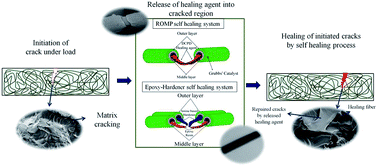Repeated self-healing of nano and micro scale cracks in epoxy based composites by tri-axial electrospun fibers including different healing agents†
Abstract
Multi-walled healing fibers with a novel architecture are fabricated through a direct, one-step tri-axial electrospinning process to encapsulate different healing agents inside the fibers with two distinct protective walls. Self healing systems based on ring opening metathesis polymerization (ROMP) and an amine–epoxy reaction are redesigned by utilizing these tri-axial fibers. In ROMP, Grubbs' catalysts are integrated in the outer wall of the fibers instead of the composite matrix to reduce the catalyst amount and prevent its deactivation during composite production. In the amine–epoxy healing system, epoxy resin and an amine-based curing agent are encapsulated separately by a multi-axial electrospinning. The presence of an extra layer facilitates the encapsulation of amine based healing agents with a highly active nature and extends the efficiency and life-time of the healing functionality. These new self-healing designs provide repeated self healing ability to preserve the mechanical properties of the composite by repairing micro and nano scale cracks under high loadings.


 Please wait while we load your content...
Please wait while we load your content...